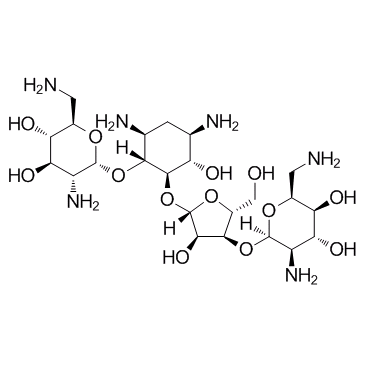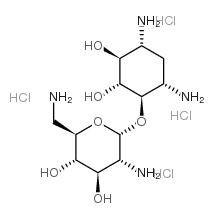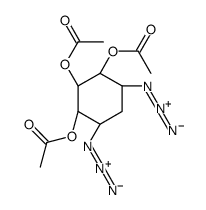119-04-0
| Name | framycetin |
|---|---|
| Synonyms |
soframycine
framygen enterfram soframycin NEOMYCIN B actilin antibiotique actiline EINECS 204-292-2 Neomycin solution |
| Description | Framycetin (Fradiomycin B; Neomycin B) is an aminoglycoside antibiotic. It inhibits hammerhead ribozyme with a Ki of 13.5 μM. |
|---|---|
| Related Catalog | |
| Target |
Ki: 13.5 μM (hammerhead ribozyme)[1] |
| In Vitro | Neomycin B is used clinically to treat hepatic encephalopathy (by reducing ammonium levels in the gut) and enteropathogenic Escherichia coli infections. Neomycin B targets the bacterial and human ribosome and affect translation. Addition of neomycin B, to an HCC cell line selectively inhibits production of the mature miRNA, boosts a downstream protein, and inhibits invasion[2]. Neomycin B interacts with various target RNAs that have no primary sequence homology. This means that the drug binds to a structural rather than a sequence motif of the RNA. Its primary cognate target is the decoding site of the 16S rRNA, but it also binds to the Rev-responsive element in HIV-1, group I introns, and the hammerhead ribozyme, and thus inhibits their biological function[3]. The aminoglycoside antibiotic neomycin B induces misreading of the genetic code during translation and inhibits several ribozymes. The ribosomal target site of neomycin B is the 16 S rRNA 1400 to 1500 region, which has been clearly demonstrated by dissecting this domain from a small RNA of 27 nucleotides. This small subdomain of the 16 S rRNA is protected from chemical modification by neomycin atthe same positions as in the context of the 30 S subunit[4]. |
| References |
[1]. Stage TK, et al. Inhibition of the hammerhead ribozyme by neomycin. RNA. 1995 Mar;1(1):95-101. |
| Density | 1.61 g/cm3 |
|---|---|
| Boiling Point | 927.1ºC at 760 mmHg |
| Molecular Formula | C23H46N6O13 |
| Molecular Weight | 614.64400 |
| Flash Point | 514.5ºC |
| Exact Mass | 614.31200 |
| PSA | 353.11000 |
| Index of Refraction | 1.6000 (estimate) |
| Storage condition | 2-8°C |
Synonym:Framycetin Sulphat Section 2 - COMPOSITION, INFORMATION ON INGREDIENTS
Risk Phrases: None Listed. Section 3 - HAZARDS IDENTIFICATION EMERGENCY OVERVIEW
Hygroscopic (absorbs moisture from the air).The toxicological properties of this material have not been fully investigated. Potential Health Effects Eye: May cause eye irritation. The toxicological properties of this material have not been fully investigated. Skin: May cause skin irritation. The toxicological properties of this material have not been fully investigated. Ingestion: May cause irritation of the digestive tract. The toxicological properties of this substance have not been fully investigated. Inhalation: May cause respiratory tract irritation. The toxicological properties of this substance have not been fully investigated. Chronic: No information found. Section 4 - FIRST AID MEASURES Eyes: Flush eyes with plenty of water for at least 15 minutes, occasionally lifting the upper and lower eyelids. Get medical aid. Skin: Get medical aid. Flush skin with plenty of water for at least 15 minutes while removing contaminated clothing and shoes. Wash clothing before reuse. Ingestion: Never give anything by mouth to an unconscious person. Get medical aid. Do NOT induce vomiting. If conscious and alert, rinse mouth and drink 2-4 cupfuls of milk or water. Inhalation: Remove from exposure and move to fresh air immediately. If not breathing, give artificial respiration. If breathing is difficult, give oxygen. Get medical aid. Notes to Physician: Section 5 - FIRE FIGHTING MEASURES General Information: As in any fire, wear a self-contained breathing apparatus in pressure-demand, MSHA/NIOSH (approved or equivalent), and full protective gear. During a fire, irritating and highly toxic gases may be generated by thermal decomposition or combustion. Extinguishing Media: In case of fire, use water, dry chemical, chemical foam, or alcohol-resistant foam. Use agent most appropriate to extinguish fire. Do NOT get water inside containers. Use water spray, dry chemical, carbon dioxide, or appropriate foam. Section 6 - ACCIDENTAL RELEASE MEASURES General Information: Use proper personal protective equipment as indicated in Section 8. Spills/Leaks: Clean up spills immediately, observing precautions in the Protective Equipment section. Sweep up or absorb material, then place into a suitable clean, dry, closed container for disposal. Provide ventilation. Do not get water inside containers. Section 7 - HANDLING and STORAGE Handling: Wash thoroughly after handling. Remove contaminated clothing and wash before reuse. Use with adequate ventilation. Avoid contact with eyes, skin, and clothing. Keep container tightly closed. Avoid ingestion and inhalation. Do not allow contact with water. Keep from contact with moist air and steam. Storage: Store in a tightly closed container. Store in a cool, dry, well-ventilated area away from incompatible substances. Store protected from moisture. Section 8 - EXPOSURE CONTROLS, PERSONAL PROTECTION Engineering Controls: Use adequate ventilation to keep airborne concentrations low. Exposure Limits CAS# 119-04-0: Personal Protective Equipment Eyes: Wear appropriate protective eyeglasses or chemical safety goggles as described by OSHA's eye and face protection regulations in 29 CFR 1910.133 or European Standard EN166. Skin: Wear appropriate protective gloves to prevent skin exposure. Clothing: Wear appropriate protective clothing to prevent skin exposure. Respirators: Follow the OSHA respirator regulations found in 29 CFR 1910.134 or European Standard EN 149. Use a NIOSH/MSHA or European Standard EN 149 approved respirator if exposure limits are exceeded or if irritation or other symptoms are experienced. Section 9 - PHYSICAL AND CHEMICAL PROPERTIES Physical State: Liquid Color: Not available. Odor: None reported. pH: Not available. Vapor Pressure: Not available. Viscosity: Not available. Boiling Point: Not available. Freezing/Melting Point: Not available. Autoignition Temperature: Not available. Flash Point: Not available. Explosion Limits, lower: Not available. Explosion Limits, upper: Not available. Decomposition Temperature: Solubility in water: 6.3 mg/ml (28 c) Specific Gravity/Density: Molecular Formula: C23H46N6O13.3H2SO4 Molecular Weight: 908.89 Section 10 - STABILITY AND REACTIVITY Chemical Stability: Stable under normal temperatures and pressures. Conditions to Avoid: Incompatible materials, moisture, strong oxidants. Incompatibilities with Other Materials: Oxidizing agents. Hazardous Decomposition Products: Nitrogen oxides, carbon monoxide, oxides of sulfur, irritating and toxic fumes and gases, carbon dioxide, nitrogen. Hazardous Polymerization: Has not been reported. Section 11 - TOXICOLOGICAL INFORMATION RTECS#: CAS# 119-04-0: QP4025000 LD50/LC50: CAS# 119-04-0: Oral, mouse: LD50 = 1250 mg/kg. Carcinogenicity: Neomycin B Sulfate - Not listed by ACGIH, IARC, or NTP. Other: See actual entry in RTECS for complete information. Section 12 - ECOLOGICAL INFORMATION Section 13 - DISPOSAL CONSIDERATIONS Dispose of in a manner consistent with federal, state, and local regulations. Section 14 - TRANSPORT INFORMATION IATA Not regulated as a hazardous material. IMO Not regulated as a hazardous material. RID/ADR Not regulated as a hazardous material. Section 15 - REGULATORY INFORMATION European/International Regulations European Labeling in Accordance with EC Directives Hazard Symbols: Not available. Risk Phrases: Safety Phrases: S 24/25 Avoid contact with skin and eyes. S 28A After contact with skin, wash immediately with plenty of water. S 37 Wear suitable gloves. S 45 In case of accident or if you feel unwell, seek medical advice immediately (show the label where possible). WGK (Water Danger/Protection) CAS# 119-04-0: 2 Canada None of the chemicals in this product are listed on the DSL/NDSL list. CAS# 119-04-0 is not listed on Canada's Ingredient Disclosure List. US FEDERAL TSCA CAS# 119-04-0 is not listed on the TSCA inventory. It is for research and development use only. SECTION 16 - ADDITIONAL INFORMATION N/A |
CHEMICAL IDENTIFICATION
HEALTH HAZARD DATAACUTE TOXICITY DATA
|
| Hazard Codes | Xn: Harmful; |
|---|---|
| Risk Phrases | R42/43 |
| Safety Phrases | S26;S45;S36/S37/S39 |
| WGK Germany | 2 |
| Precursor 0 | |
|---|---|
| DownStream 4 | |




